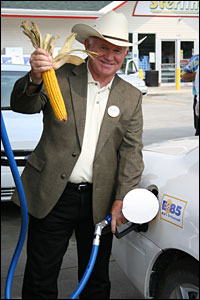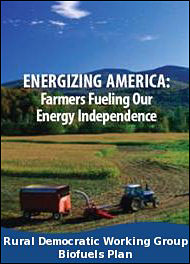If you’re like the rest of us, you’ve probably heard of E85 — yet don’t have the slightest idea what it is. Or if you do have an idea, it’s, well, slight. But never fear, friends and neighbors: We’ve got the skinny on the corn-a-rific fuel that’s increasingly on the tips of tongues and in the depths of gas tanks.

Lend us your ears.
Photo: Ohio Dept. of Agriculture
So … what is it?
E85 is a motor fuel that is a blend of 15 percent unleaded gasoline and 85 percent ethanol, by volume. In the U.S., ethanol is usually derived from corn, but it can be made from virtually any starch. The U.S. Department of Energy defines E85 as an “alternative fuel,” as it’s an alternative to the straight-up oil-dependent gasoline that is the U.S. standard.
Why should I care?
Proponents of E85 emphasize that it burns nearly 30 percent cleaner than gasoline. Compared to gas-fueled vehicles, vehicles running on E85 emit about the same amount of nitrogen oxides, the same or lower levels of hydrocarbon and non-methane hydrocarbon, and less carbon monoxide and carbon dioxide. Ethanol can also be produced from domestic crops, boosting the U.S. economy and moving us toward ever-out-of-our-reach energy independence. And, say boosters, demand for E85 will encourage the growth of more crops, which suck up CO2.
Sounds great. What could go wrong?
Naysayers naysay that, this being the U.S., ethanol is unlikely to be produced in a sustainable way that benefits local farmers. Large-scale plantations will likely require lots of genetically modified seeds, pesticides, and nitrogen fertilizer. Opponents also see the potential, hopefully not realized, for forests to be cut down to make room for corn plantations, or for the emphasis on fuel crops to disrupt the food supply.
OK, while I’m weighing the pros and cons: Where can I get it?
It’s big in Sweden. Oh, you don’t live there? Well, many existing gasoline and diesel fuel systems in the U.S. can be cleaned out and used to store and dispense E85 — so just go to your nearest E85-dispensing station. It’ll be in the tank marked with a bronze-colored pentagon that says “E85.”
I drove around for ages looking, and I can’t find one.
Oh, we forgot to mention: There are only about 600 E85 fueling stations in the U.S. at the moment — and 300 of those are in Minnesota. If you live in Alabama, Alaska, Connecticut, Delaware, Hawaii, Louisiana, Maine, New Hampshire, New Jersey, Rhode Island, or Vermont, you’re outta luck — there are no E85 fueling stations in your state. For the rest of you, here’s a map of E85 stations in your area.
Wait, I’m corn-fused. I found my filling station and it has a sticker that says E85: Minimum 70 percent ethanol. I thought it was 85 percent ethanol?
Glad you asked. In cold weather, more gasoline needs to be added to ethanol-gasoline blends in order to ensure that they work properly. Thus, the “winter blend” requires a minimum of 70 percent ethanol. For the same reason, E85 is likely to be slightly more expensive in the winter than the summer.
That was my next question: What’s it gonna cost me?
As of 2005, E85 in the U.S. was selling for about 36 percent lower price per quantity than gasoline, thanks to federal and state government subsidies and tax breaks. But don’t be surprised if you find it for the same price as gasoline. Its price will vary just like gasoline prices.
Can I just go out and fill up my standard gasoline-powered car with E85?
It’s not a great idea. Ethanol is incompatible with a variety of metals and materials used in normal fuel tanks, and will cause wear and tear. May we recommend to you a flex-fuel vehicle, which can run on any blend of gasoline and ethanol (up to 85 percent ethanol), as well as on straight gasoline? You can find lists of FFVs here — they can be purchased for little or no more than a standard vehicle.
Can I convert my car to run on E85?
You can, but it’s not recommended. Conversion kits are illegal in the U.S. unless they’re EPA-certified, for safety reasons.
How will E85 affect my FFV’s fuel economy?
One gallon of E85 contains 27 percent less energy than gasoline — thus, your miles per gallon will be reduced roughly proportionally. The older your FFV, the worse the fuel economy tends to be.
Well, that sucks.
It does. But E85 is high-octane (an octane rating of 100 to 105, compared to 87 for standard gasoline), so you can cruise with the best of ’em — Ford found that FFVs’ power typically increased 5 percent running on E85 rather than gasoline.
What does E85 look like?
Gasoline, more or less. Pure ethanol is a colorless liquid, so it takes on the shade of gasoline when blended.
Hypothetical: a huge E85 tanker runs aground and spills its goods into the ocean. Would this be, as they say, bad?
The marine life would be unlikely to welcome the 15 percent gasoline in the mixture, but ethanol is water-soluble, nontoxic, and biodegradable.
I recall seeing Daryl Hannah lick the gas cap of her biodiesel car. Can I drink E85?
No. While 100 percent ethanol was at some point in its life cycle basically the alcohol in your alcoholic beverage and was technically imbibe-able, industrial distillers have to make it undrinkable with toxic or nasty-tasting substances to avoid an alcoholic beverage tax. Plus, there’s gasoline in E85. Um, gross.


